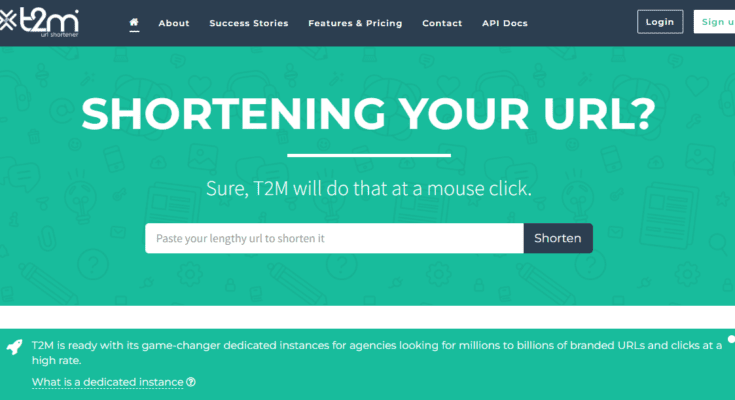Every web developer must abbreviate a URL at some point in their career. Making a link smaller to fit in print, making a link more memorable, doing an A/B test, retargeting a link for market research, hiding tracking links, or possibly changing a link, later on, are all possible reasons (link rotation).Developers who want to use c should look for URL shortener APIs.
What is an API for URL shorteners?
An application programmer interface, or API, for URL shortening services, enables developers to incorporate URL shortening services into their apps or to add those features to already existing applications.
The ProgrammableWeb directory’s URL Shortener category is the best location to look for these APIs. There, programmers can find practical programming tools like URL-shortening APIs.
We describe the most well-liked URL shortener APIs in this post.
T2M URL Shortener API
The T2M URL shortener includes a simple method for shortening large URLs and the ability to monitor every click. T2M URL Shortener can shorten long links with a single click and offers a fully functional API along with a variety of other possibilities. As the world became more digital, T2M URL shorteners became a frequently used service for many marketing efforts.
The T2M URL shortener:
- When managing their digital assets, provide users with an overview of digital content assets and their dependencies.
- Verify whether removing a page from publication will affect the short URLs that point to it.
- show an alternate way of using the page.
- Indicate any digital assets that might be relevant to content from another department.
Integrate T2M URL shortener with API
- From the main menu, select Integrations > Integrations Overview.
- In the URL shorteners area, look for the T2M integration.
- Select “Connect” from the menu.
- Give your T2M URL shortener an original name.
- Type in the T2M-generated key.
- Type in the Secret Token produced by T2M.
- Select “Connect to T2M” from the menu
- You will be taken to the Manage URL Shorteners page of the Integrations menu and notified that your T2M account has been successfully connected.
Bitly API
Users can share, track, and shorten URLs using Bitly. You can use Bitly’s functionality by visiting their website and using bookmarklets. Users of the Bit.ly service can personalize shortened links by adding their company names or other terms.
Ow.ly API
Users of the link-shortening and expansion tool OW.LY can shorten or lengthen URLs for web pages, uploaded images, and uploaded documents. The Ow.ly APII enables developers to incorporate Ow.ly’s methods for URL expansion, URL shortening, URL information retrieval, and click statistics with other applications. The Hootsuite social media management features include Ow.ly.
Tiny-URL API
Shortening URLs is a feature offered by the Tiny-URL Open API. Tiny-URL connects to more than 80 additional services rather than just a single URL shortener. The RESTful protocol is used by the API, and replies can be either formatted in XML, JSON, or TXT.
Hide URL API
Applications can now use URL shorteners thanks to Hide URI. The abbreviated URLs are returned as JSON objects by the REST API.
Rebrandly API
An individual URL shortener is Rebrandly. With the Rebrandly API Track, users can incorporate branded short link creation, tracking, and sharing functionality into their apps.
Mgnet.me shortener API
Magnet: URI scheme is shortened at mgnet.me. Magnet links are frequently used to refer to files that can be downloaded using peer-to-peer networks. The Mgnet.me API offers the same functionality with output formats for XML, JSON, and text.





